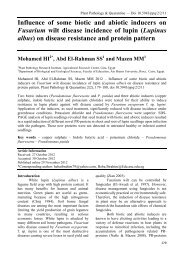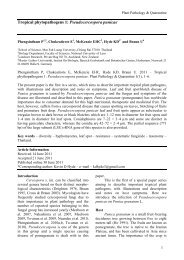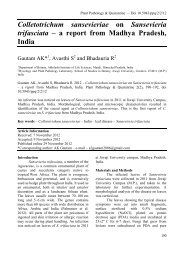Genus Cercospora in Thailand: Taxonomy and Phylogeny (with a ...
Genus Cercospora in Thailand: Taxonomy and Phylogeny (with a ...
Genus Cercospora in Thailand: Taxonomy and Phylogeny (with a ...
Create successful ePaper yourself
Turn your PDF publications into a flip-book with our unique Google optimized e-Paper software.
vate <strong>and</strong> short conidia <strong>with</strong> a few septate<br />
(Chupp 1954). However, the status of C.<br />
lanugiflori is unclear (Crous & Braun 2003),<br />
therefore, this specimen is assigned to C.<br />
solanacea. <strong>Cercospora</strong> solanacea was first<br />
reported from <strong>Thail<strong>and</strong></strong> by Meeboon (2009).<br />
Literature – Chupp (1954, p. 549–550).<br />
Verbenaceae<br />
<strong>Cercospora</strong> tectonae F. Stevens (tectoniae),<br />
Bernice P. Bishop Mus. Bull. 19: 155 (1925).<br />
(= C. apii s. lat.) Fig. 65<br />
Leaf spots 2–14 mm <strong>in</strong> diam., angular<br />
to suborbicular, limited by leaf ve<strong>in</strong>s, confluent,<br />
brown to greyish brown or white at the centre,<br />
<strong>with</strong> a dark marg<strong>in</strong>. Caespituli amphigenous,<br />
chiefly epiphyllous. Stromata 8–41 µm diam.,<br />
small to well–developed, composed of a few<br />
globose to subglobose, brown to dark brown<br />
cells. Conidiophores 33.5–76 × 3–5 µm, <strong>in</strong><br />
loose fascicules, 1–5–septate, straight to decumbent,<br />
light brown to medium brown, paler<br />
towards the apex, geniculate at the apex.<br />
Conidiogenous cells <strong>in</strong>tegrated, term<strong>in</strong>al, holoblastic,<br />
polyblastic, sympodially proliferat<strong>in</strong>g.<br />
Conidiogenous loci 2–3 µm diam., conspicuous,<br />
thickened <strong>and</strong> darkened. Conidia 31–96.5 × 2–<br />
3 µm, hyal<strong>in</strong>e, acicular to obclavate–cyl<strong>in</strong>dric,<br />
4–13–septate, straight to curved, truncate or<br />
obconically truncate at the base, <strong>with</strong> subacute<br />
82<br />
apex, hila 2–2.5 µm diam., thickened <strong>and</strong><br />
darkened.<br />
Specimen exam<strong>in</strong>ed – THAILAND,<br />
Chiang Mai Prov<strong>in</strong>ce, Chiang Mai University,<br />
Multiple Cropp<strong>in</strong>g Centre, on leaves of<br />
Tectona gr<strong>and</strong>is L.f. (Verbenaceae), 1<br />
December 2005, Jamjan Meeboon (CMU<br />
27928).<br />
Hosts – Tectona gr<strong>and</strong>is (Verbenaceae)<br />
(Crous & Braun 2003, Meeboon et al. 2007c).<br />
Distribution – Ch<strong>in</strong>a, Indonesia, Taiwan,<br />
<strong>Thail<strong>and</strong></strong>, Tr<strong>in</strong>idad <strong>and</strong> Tobago, USA (Crous &<br />
Braun 2003, Meeboon et al. 2007c).<br />
Notes – Crous & Braun (2003) assigned<br />
this species to C. apii s.lat. The first report of C.<br />
tectonae from <strong>Thail<strong>and</strong></strong> was by Meeboon et al.<br />
(2007c).<br />
Literature – Chupp (1954, p. 595)<br />
Z<strong>in</strong>giberaceae<br />
<strong>Cercospora</strong> alp<strong>in</strong>iicola S.Q. Chen & P.K. Chi<br />
(alp<strong>in</strong>icola), Journal of South Ch<strong>in</strong>a<br />
Agricultural University 11: 57 (1990b); also <strong>in</strong><br />
Chi, Fungal Diseases of Cultivated Medic<strong>in</strong>al<br />
Plants <strong>in</strong> Guangdong Prov<strong>in</strong>ce: 33 (1994).<br />
Fig. 66<br />
Leaf spots 2–13 mm diam., amphigenous,<br />
dist<strong>in</strong>ct, circular to irregular, pale olivaceous<br />
brown at the center, sometimes discoloration<br />
form<strong>in</strong>g surround<strong>in</strong>g the marg<strong>in</strong>. Caespituli<br />
amphigenous. Stromata 12.5–19 μm diam.,<br />
Fig. 65 – L<strong>in</strong>e draw<strong>in</strong>gs of <strong>Cercospora</strong> tectonae on Tectona gr<strong>and</strong>is. a. Conidia. b. Conidiophores<br />
<strong>and</strong> stromata. Bars = 50 μm. (Meeboon 2009).









